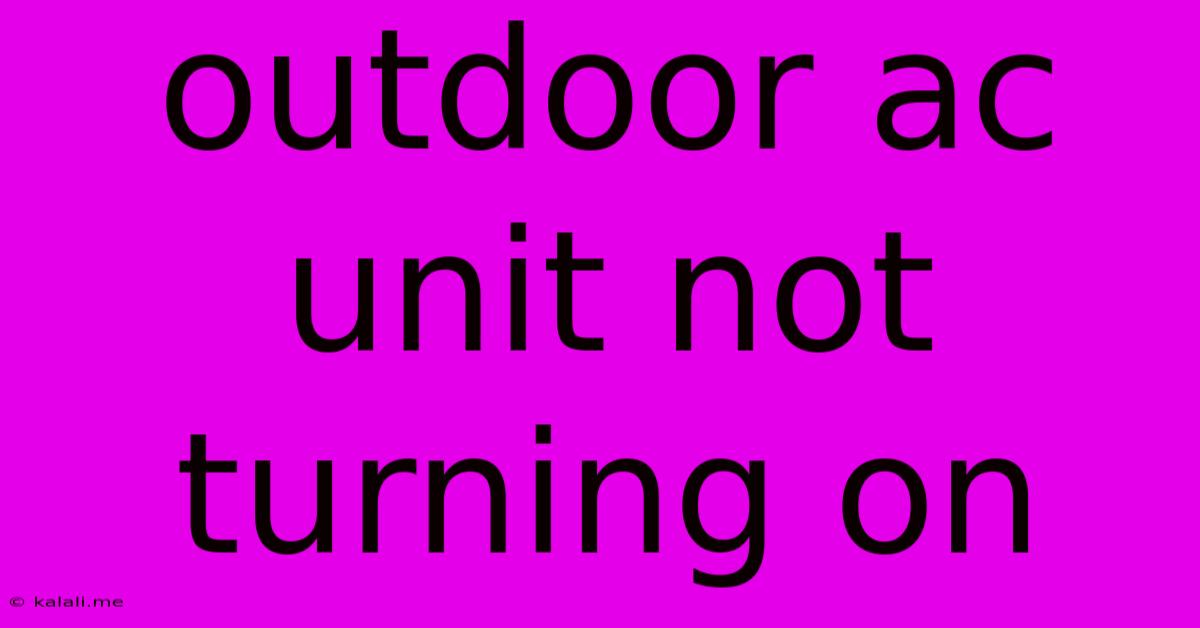Outdoor Ac Unit Not Turning On
Kalali
Jun 11, 2025 · 3 min read

Table of Contents
Outdoor AC Unit Not Turning On: Troubleshooting & Solutions
Meta Description: Is your outdoor AC unit refusing to turn on? This comprehensive guide walks you through common causes, troubleshooting steps, and potential solutions to get your air conditioning back up and running. Learn how to diagnose problems like tripped breakers, faulty capacitors, and refrigerant leaks.
Summer heat can be unbearable, and when your outdoor AC unit suddenly stops working, it becomes a major inconvenience. Before calling a costly repair technician, let's troubleshoot the problem together. This guide will provide a step-by-step approach to diagnosing why your outdoor AC unit isn't turning on, empowering you to potentially fix it yourself or at least better understand the issue before calling for professional help.
1. Check the Power Supply
The most common reason an outdoor AC unit won't start is a power problem. Begin by checking these crucial areas:
-
Circuit Breaker: Locate your home's electrical panel and check the breaker dedicated to your air conditioner. Is it tripped (switched to the "off" position)? If so, simply switch it back on. If it immediately trips again, there's a more serious electrical fault that requires professional attention.
-
Power Cord: Examine the power cord connecting the outdoor unit to the power source. Look for any visible damage, such as fraying, cracks, or loose connections. A damaged cord needs immediate replacement by a qualified electrician.
-
Disconnect Switch: Some units have a disconnect switch near the outdoor unit. Ensure this switch is in the "on" position.
2. Inspect the Condenser Fan
The condenser fan is essential for cooling. If it's not working, the unit won't start.
-
Visual Inspection: Look for any obvious obstructions like leaves, debris, or nesting animals blocking the fan blades. Clear any obstructions carefully.
-
Manual Spin: Gently try to spin the fan blades by hand. If they turn freely, the problem likely lies elsewhere. If they're stiff or don't turn easily, there might be a mechanical issue within the fan motor itself.
3. Examine the Capacitor
The capacitor is an electrical component that helps the motor start. A faulty capacitor is a common cause of failure. However, working with capacitors can be dangerous due to the stored electrical charge. If you're not comfortable handling electrical components, call a qualified technician.
- Visual Inspection: Look for any visible signs of damage on the capacitor, such as bulging, leaking, or burnt markings. A visibly damaged capacitor should be replaced by a professional.
4. Check the Refrigerant Levels
Low refrigerant levels can prevent the AC unit from starting. This is a job best left to professionals. Refrigerant handling requires specialized equipment and knowledge; attempting to refill it yourself can be dangerous and void any warranties. If you suspect low refrigerant, contact an HVAC technician immediately.
5. Evaluate the Compressor
The compressor is the heart of the air conditioning system. A faulty compressor often requires professional repair or replacement.
-
Listen for Unusual Noises: If you hear unusual grinding or clicking sounds when attempting to start the unit, it suggests a problem with the compressor.
-
Noisy Operation: Even if it briefly starts, excessive noise could indicate a failing compressor that requires professional attention.
6. Consider the Control Board
The control board acts as the brain of the AC unit. A faulty control board will prevent the unit from starting. Diagnosing and replacing a control board requires specialized knowledge and equipment, making it another job best left to a qualified technician.
When to Call a Professional
While some of these steps can be performed by a homeowner with basic DIY skills, certain issues require the expertise of a qualified HVAC technician. Don't hesitate to contact a professional if:
- The circuit breaker continues to trip.
- You suspect a refrigerant leak.
- You're uncomfortable working with electrical components.
- The problem persists after trying the above troubleshooting steps.
By systematically checking these areas, you can significantly increase your chances of identifying and potentially resolving the issue preventing your outdoor AC unit from turning on. Remember safety first, and don't hesitate to call for professional help when needed.
Latest Posts
Latest Posts
-
49 Countries In Asia And Their Capitals Pdf
Jun 12, 2025
-
Difference Between Woody And Herbaceous Plants
Jun 12, 2025
-
The American University Of Paris Acceptance Rate
Jun 12, 2025
-
St Georges University Grenada Acceptance Rate
Jun 12, 2025
-
Uppsc Agriculture Services Pre Answer Key 2024 By Sarkarijobofficial In
Jun 12, 2025
Related Post
Thank you for visiting our website which covers about Outdoor Ac Unit Not Turning On . We hope the information provided has been useful to you. Feel free to contact us if you have any questions or need further assistance. See you next time and don't miss to bookmark.